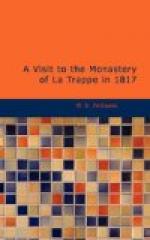I arrived at Clisson just as the sun was disappearing, and its rays were only sufficiently strong to reflect the ruined towers of the Castle in the river which runs at its foot. It will be much easier to imagine, than for me to convey the sensations I felt when I first caught a glimpse of it, with the story of La Roche-Jaquelin full in my recollection! I alighted at a small cabaret, dignified by the appellation of the Hotel de la Providence, which seemed preferable to another recommended to me by my guide,—such an one, indeed, as might be expected in a remote place like this: part of the roof was off, and, like most of the houses in the place, bore evident marks of the desolating war that had been carried on here: many are still in ruins. The descent into the town is very steep and rugged, the road being formed out of the solid rock. The master of the cabaret was sitting with his family at the door, but the appearance of his mansion was so unpromising, that I thought it best to make some agreement, and a few inquiries before dismounting;—these preliminaries being settled, and having consented to pay him fifty sous for supper and my bed, and thirty for breakfast, I entered the house: and never recollect having a keener relish for a meal, or enjoying one more heartily, for I had been sixteen hours on horseback.
Fatigued and exhausted as I was, I rambled after dinner towards the delightful grounds of La Garenne, belonging to Monsieur La Motte, who has embellished them in a most interesting and romantic manner.
The river Sevres runs along the side, and separates them from the fine old Castle of Clisson, whose high and decaying towers and battlements give the beholder a noble idea of its ancient grandeur. The evening was a very fine one,—one of those delightful soft, clear skies usual at this season, the latter end of July. I sat myself down in the grotto of Heloise,—a spot of the deepest seclusion, formed, by the hand of Nature, of large masses of granite. The nightingales were singing in the lofty trees at the back; on the sides were shrubs of every description intermingled with fruit trees, and the river having several falls and little rocky islets, gave an air of delightful enchantment to this most romantic scene.
Heloise! a ce nom, qui ne doit s’attendrir?
Comme elle sut aimer! comme elle sut souffrir!
At the entrance of the grotto are engraved these lines, nearly effaced by the hand of time.
Heloise peut-etre erra sur ce rivage,
Quand, aux yeux des jaloux derobant son
sejour,
Dans les murs du Palet elle vint mettre
au jour
Un fils, cher et malheureux gage
De ses plaisirs furtifs et de son tendre
amour.
Peut-etre en ce reduit sauvage,
Seule, plus d’une fois, elle vint
soupirer,
Et gouter librement la douceur de pleurer;
Peut-etre sur ce roc assise
Elle revait a son malheur.
J’y veux rever aussi; j’y
veux remplir mon coeur
Du doux souvenir d’Heloise.




